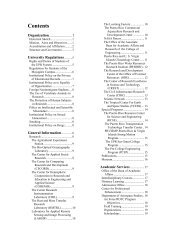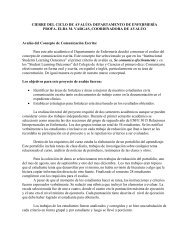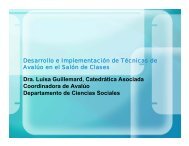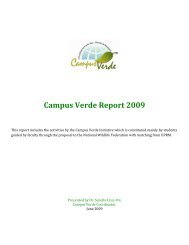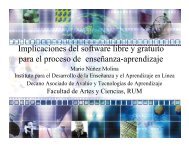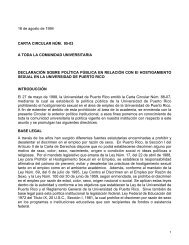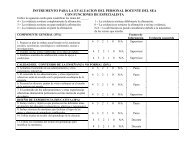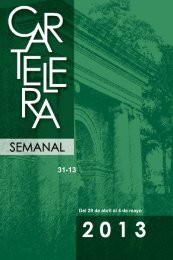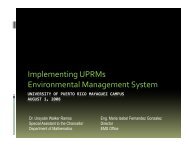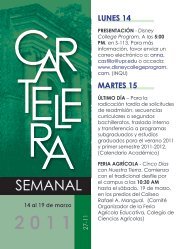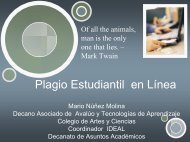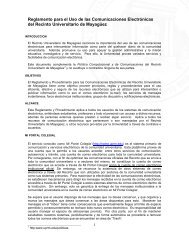Undergraduate Catalogue - UPRM
Undergraduate Catalogue - UPRM
Undergraduate Catalogue - UPRM
You also want an ePaper? Increase the reach of your titles
YUMPU automatically turns print PDFs into web optimized ePapers that Google loves.
18Research<br />
Civil Infrastructure Research Center<br />
Founded in 1991, CIRC began operating within<br />
the Civil Engineering Department in January<br />
1992. CIRC received funds from the National<br />
Science Foundation through the PR office of the<br />
Experimental Program to Stimulate Cooperative<br />
Research (PR-EPSCoR). The center also<br />
received funds from the University of Puerto<br />
Rico and the Department of Transportation and<br />
Public Works. It has also participated in the<br />
organization of international conferences and<br />
workshops.<br />
CIRC’s mission is to help government and<br />
industry maintain, manage, and improve Puerto<br />
Rico’s infrastructure while contributing to the<br />
expansion and improvement of the College of<br />
Engineering’s undergraduate and graduate<br />
programs in infrastructure-related disciplines.<br />
CIRC developed a comprehensive strategic plan<br />
which can be accessed at http://ce.uprm.edu.<br />
The research program of the Civil Infrastructure<br />
Research Center was originally organized into<br />
two principal thrust areas and a developing thrust<br />
area. These thrust areas have been defined by<br />
the intersection of Puerto Rico’s most pressing<br />
infrastructure problems and the UPR Mayagüez<br />
Civil Engineering Department’s strongest areas<br />
of expertise. The principal thrusts are<br />
Transportation and Structural and Geotechnical<br />
Systems. The developing thrust is in Water<br />
Resources.<br />
At present, the Center plans projects with the<br />
Federal Emergency Management Agency, the<br />
Sloan Foundation, the National Science<br />
Foundation, USAERDC, USDOT, and the<br />
Puerto Rico Department of Transportation and<br />
Public Works.<br />
The Civil Infrastructure Research Center has a<br />
computer center. The computer center was<br />
developed with funds from Puerto Rico<br />
EPSCoR, the Puerto Rico Legislature, the<br />
National Science Foundation, and the Civil<br />
Engineering Department. Our computer center<br />
exists to support all CIRC researchers.<br />
Since our foundation, the center has administered<br />
$5,125,352 in completed projects. It manages<br />
$2,384,396 in on-going projects. The center<br />
actively participates in developing new proposals<br />
to support our goals. For more information<br />
contact http://ce.uprm.edu.<br />
Puerto Rico Seismic Network<br />
PRSN is administered by the Department of<br />
Geology. The staff oversees a network of shortperiod<br />
and broadband seismometers installed in<br />
Puerto Rico and nearby islands. The main<br />
objective of PRSN is to process and analyze<br />
local, regional, and teleseismic earthquakes.<br />
Data is made available to the general public and<br />
distributed among scientific and academic<br />
communities and civil defense organizations.<br />
Tropical Center for Earth and Space Studies<br />
TCESS is funded by NASA’s University<br />
Research Centers (URC) Program. It is divided<br />
administratively into five components:<br />
1. Space Information Laboratory (SIL)<br />
2. Earth Systems Studies (ESS)<br />
3. Advanced Automated Image Analysis<br />
(AAIA) for Remotely Sensed Data<br />
4. Sensor Materials and Electronics for<br />
Space Applications (SMESA)<br />
5. Outreach and Education<br />
The Space Information Laboratory<br />
Built on the foundations of LARSIP, it is funded<br />
by contributions from NASA, UPR, and<br />
Fomento (Commonwealth Economic<br />
Development) <strong>UPRM</strong> installed and operates<br />
Synthetic Aperture Radar (SAR) and HRPT<br />
tracking stations. These are national facilities<br />
available by invitation to other NASA and US<br />
university researchers. SIL is a training center<br />
for scientists and engineers in a bilingual<br />
environment. The Laboratory provides<br />
opportunities for research applicable to the<br />
problems of the Caribbean area. The Earth<br />
Systems Studies component contains two<br />
working groups who have participated in other<br />
NASA programs. The Geology Group<br />
investigates surface deformations and hazards of<br />
Lesser Antilles island arc volcanoes. The<br />
Marine Sciences Group investigates the effects<br />
of the thinning of the ozone layer and related<br />
surface UV radiation modulation on the<br />
development of plant screening pigments.<br />
The Advanced Analysis Information Systems<br />
Group from Electrical and Computer<br />
Engineering investigates new image-processing<br />
algorithms and techniques for storage,<br />
processing, and dissemination of remotely-<br />
18 <strong>Undergraduate</strong> <strong>Catalogue</strong> 2004-2005



